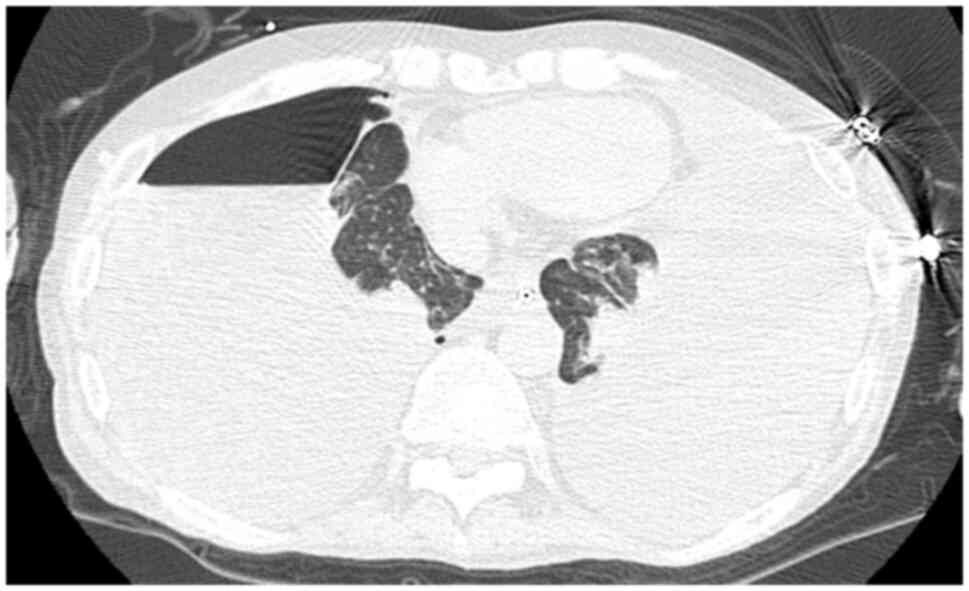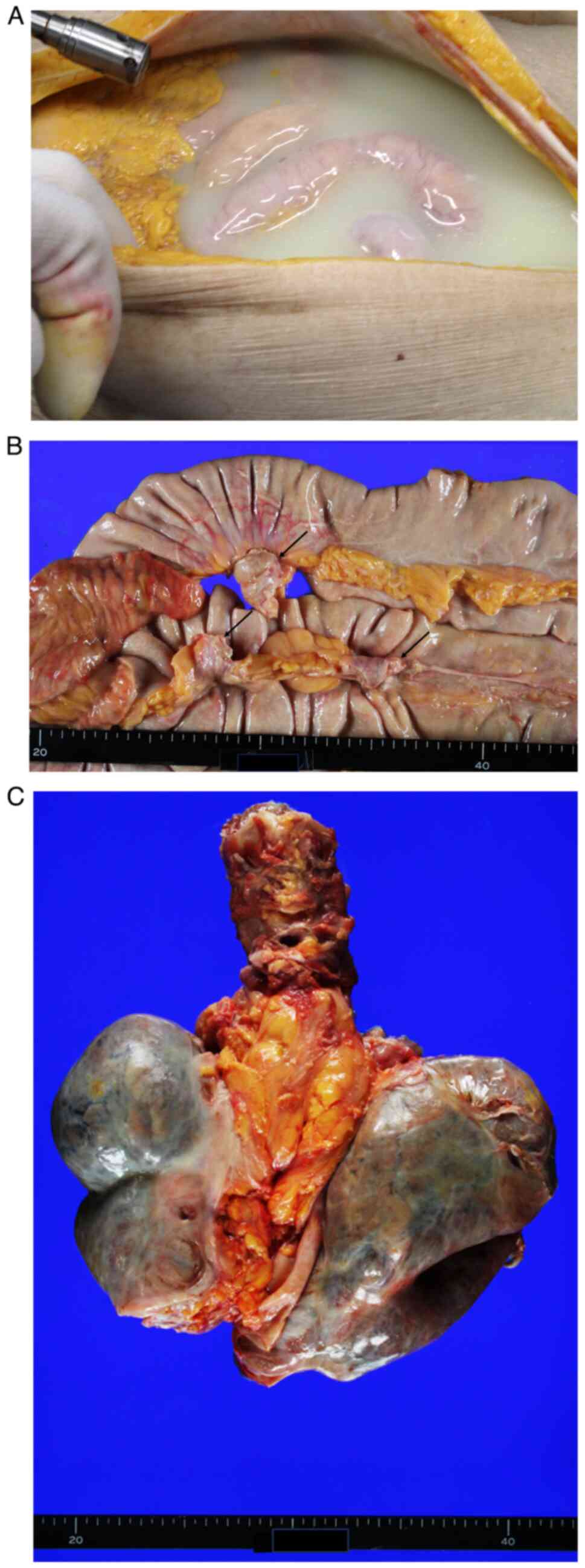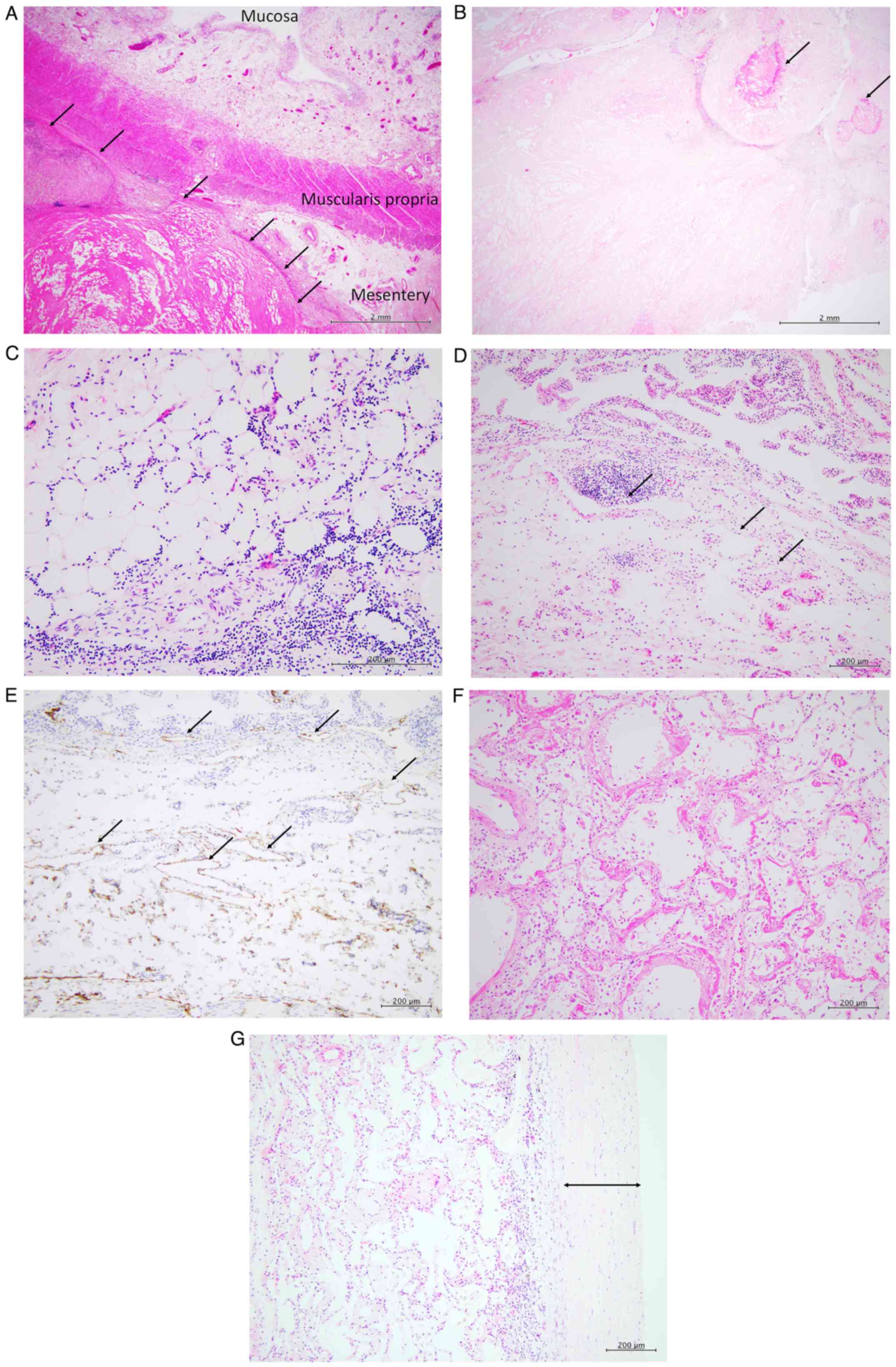Massive chylous pleural effusion and protein‑losing enteropathy caused by mesenteric panniculitis: A case report
- Authors:
- Published online on: August 19, 2024 https://doi.org/10.3892/br.2024.1836
- Article Number: 148
-
Copyright: © Nakazawa et al. This is an open access article distributed under the terms of Creative Commons Attribution License.
Abstract
Introduction
Mesenteric panniculitis (MP) is a rare idiopathic condition characterised histologically by chronic inflammatory and fibrosis of mesenteric adipose tissue (1-2). Ogden et al (3) introduced the term MP to encompass sclerosing mesenteritis and mesenteric lipodystrophy. While these conditions share the same features, they differ in the relative predominance of chronic inflammation or fibrosis Pathological features predominant in inflammation are termed MP, whereas those predominant in fibrosis are termed sclerosing mesenteritis (1-2). A systematic review showed that MP primarily affects middle-aged men, presenting most commonly with abdominal pain (78.1%), followed by fever (26.0%), weight loss (22.9%), diarrhoea (19.3%) and vomiting (18.2%) (1). Abdominal tenderness (38.0%) and masses (34.4%) are observed on physical examination (1). MP diagnosis is difficult due to the presentation of non-specific symptoms and unclear findings. Chylous ascites has been reported in two case series of patients with MP, demonstrating frequencies of 18.5% (minimal chylous ascites) (3) and 14.1% (no information regarding amount of ascites) (4). To the best of our knowledge, few case reports describe massive chylous ascites (5-7). Similarly, chylous pleural effusion, a rare complication in patients with MP, has only been documented in two reports, to the best of our knowledge (8-9).
Protein-losing enteropathy (PLE) is characterised by uncompensated loss of plasma protein in the intestines, leading to panhypoproteinemia in the absence of liver or kidney dysfunction (10,11). Studies have identified mucosal damage and lymph drainage failure as primary mechanisms underlying PLE, with several factors contributing to the development of these mechanisms, including inflammatory conditions (such as Crohn's disease and ulcerative colitis), cardiovascular disorders (such as chronic congestive heart failure) and widespread abdominal malignant neoplasms (such as malignant lymphoma and multiple myeloma) (10-11). To the best of our knowledge, however, only six cases of MP-associated PLE have been published (12-17).
The present study reported a case of MP complicated by massive chylous ascites, pleural effusion and PLE and reviewed clinicopathological characteristics of these conditions.
Case report
Case presentation
A 56-year-old male presented to Osaka Medical and Pharmaceutical University Hospital (Osaka, Japan, in May 2023 for dyspnoea. The patient had no history of diabetes mellitus, allergies, malignancy or thoracic/abdominal surgery, but showed a significant smoking history of 10 cigarettes/day for 34 years. The patient initially noted the development of systemic oedema, transient abdominal pain and fever and weight loss (approximately 20 kg) in June 2018; consultation revealed hypoalbuminemia (1.6 g/dl, reference range: 4.1-5.1). The patient was subsequently referred to Osaka Medical and Pharmaceutical University Hospital, Osaka, Japan, in November 2018. Physical examination revealed massive ascites, which was confirmed to be chylous on abdominal paracentesis. Endoscopy of the small intestine and duodenum revealed mucosal oedema. Histopathological specimens were fixed in 10% formalin at room temperature for 24 h, dehydrated in ethanol and xylene at room temperature, and embedded in paraffin (60˚C). The 4-micrometer sections were stained with haematoxylin and eosin for 5 min each at room temperature. Histopathological study using light microscope of duodenal mucosa showed lymphangiectasia of the lamina propria (magnification, x400). Therefore, the patient was diagnosed with PLE with massive chylous ascites. Prednisolone (20 mg/day for 3 years, per oral), albumin preparation (Albuminar 25%, twice, per intravenous injection), and diuretic agents (Spironolactone, 100 mg/day for 3 years, per oral)were administered, resulting in the improvement of oedema. During the 3 years following initial presentation, the patient reported gradual and uncontrolled fluid accumulation. A peritovenous shunt for peritoneal fluid drainage into the internal jugular vein was placed in December 2020, which stabilised symptoms.
Computed tomography (CT) (Aquilion-ONE, Canon Medical Systems, Japan) without contrast agent revealed pneumothorax of the right lung, massive bilateral pleural effusion and shrunken bilateral lungs (Fig. 1) in March 2023. Drainage of the right thoracic cavity was attempted but the right lung failed to expand. Elevated levels of white blood cells (13.63x103/µl; range: 3.3-8.6x103) and C-reactive protein (13.63 mg/dl, range: <0.14), along with ground-glass opacity on CT, indicated pulmonary infection, prompting the initiation of various antibiotic regimens [Voriconazole (300 mg x 2/day), Ampicillin/Sulbactam (3 g x 4/day), and Vancomycin (1,000 mg x 2/day) per intravenous injection for three weeks (all)]. However, due to elevated liver enzyme levels [aspartate aminotransferase, 1,467 U/l (reference range 13-30) and alanine aminotransferase 829 U/l (reference range 10-42)], antibiotics were discontinued in April 2023. Respiratory failure worsened due to increasing pleural effusion and persistent lung collapse, leading to death in April 2023.
Autopsy findings
Upon opening the abdominal wall, massive chylous ascites (3680 ml) was observed (Fig. 2A). Massive chylous pleural effusion in bilateral pleural cavities (left, 1,650; right, 2,160 ml) was also present. The mesentery of the small intestine was thickened, hardened and appeared slightly whitish in colour (Fig. 2B). Similar thickening was observed in the mesocolon. Calcified nodules, measuring 2-3 cm in diameter, were present in the small bowel mesentery (Fig. 2B), with a few identified in the mesocolon. Bilateral lungs were shrunken and their surfaces were covered with dense, white fibrous tissue (Fig. 2C). Examination of the diaphragm revealed no visible defects.
Histopathological and immunohistochemical findings
Autopsy specimens were fixed in 10% formalin at room temperature for 48 h, dehydrated in ethanol and xylene at room temperature and embedded in paraffin (60˚C). The 4-micrometer tissue sections were stained with haematoxylin and eosin for 5 min each at room temperature. Immunohistochemical analyses were performed using an autostainer (Leica Bond-III; Leica Biosystem GmbH). The 4-micrometer tissue sections were incubated with mouse monoclonal antibody against IgG4 (clone HP6025, cat. no. 605-900; 1:400 dilution, Thermo Fisher Scientific Inc.) and mouse monoclonal antibody against podoplanin (clone D2-40, cat. No. M361901-2, pre-diluted, Agilent Technologies Inc.) for 20 min at room temperature. Secondary antibodies were pre-diluted and were used to incubate the sections for 8 min at room temperature (Novolink Max Polymer Detection System (cat. No. RE7140-L; Leica Biosystems GmbH). Microscopic examination showed diffuse fat necrosis and fibrosclerosis in the mesentery of the small intestine (Fig. 3A), with calcification within the necrotic and fibrotic areas (Fig. 3B). Small lymphocytic infiltration without plasma cells was observed within the mesenteric adipose tissue surrounding necrotic areas (Fig. 3C). Immunohistochemical staining showed no IgG4-positive plasma cells. Collectively, these features supported the diagnosis of MP.
Examination of small intestine confirmed lymphangiectasia in the lamina propria of the mucosa and submucosa (Fig. 3D). This was confirmed by positive podoplanin immunostaining, a marker for lymphatic endothelial cells (18) (Fig. 3E).
Microscopic examination of bilateral lungs showed diffuse alveolar damage, characterised by hyaline membrane formation (Fig. 3F). Diffuse fibrosclerotic thickening of the visceral pleura was observed, corresponding to the gross findings of shrunken lungs covered with dense, white fibrous tissue (Fig. 3G).
Discussion
To the best of our knowledge, the present study is the first to report MP accompanied by massive chylous ascites, pleural effusion and PLE. Although a premortem diagnosis of MP was not made, histopathological examination during autopsy revealed findings that were consistent with MP. Excessive fluid buildup and protein loss were likely attributed to intestinal lymph drainage obstruction caused by mesenteric inflammation, fibrosis and fat necrosis in MP.
MP is an idiopathic condition characterised by chronic inflammation and fibrosis of mesenteric adipose tissue (1-2). MP is associated with infection, autoimmune disease and abdominal trauma (1). Certain cases of MP result from IgG4-associated diseases (19). although most cases showed no such associations (20). Therefore, the absence of IgG4-positive plasma cells in the present cased ruled out differential diagnoses for IgG4-related diseases. Since MP is predominant in middle-aged male patients presenting with non-specific symptoms, such as abdominal pain, fever, weight loss and diarrhoea (1), its diagnosis is often difficult. Previous studies have reported a postmortem diagnosis of MP, similar to the present case (9,14). Imaging studies may be valuable diagnostic tools in visualizing certain MP features. CT demonstrates hyperattenuating fat with tumoural pseudocapsules and soft tissue nodules in the mesentery (1,4,21). Magnetic resonance imaging demonstrates an ill-defined, hyperintense signal in mesenteric fat on T2-weighted imaging, reflecting early-stage oedema, followed by a hypointense signal in later stages (1). Calcification, which is a potential consequence of fat necrosis, may be observed in the mesentery (4,7,14), as in the present case. Notably, the presence of calcification might be a characteristic finding on CT scans for MP. Furthermore, while small intestinal mesentery is the most commonly affected site (1), lesions in both the small intestine and colon are possible, as in the present case. The treatment strategy for MP typically involves administration of steroids, colchicine, tamoxifen and antibiotics, with over 70% of patients showing symptom resolution (1,4,21). However, non-responders have been documented (1,4,14,15), with some developing fatal outcomes on follow-up (1,9,14). Here, the patient succumbed to respiratory failure despite medical treatment.
Massive chylous pleural effusion and PLE were rare features in the present case. Table I summarises clinicopathological characteristics of MP cases with chylous pleural effusion or PLE, including the present case (8,9,12-17). To the best of our knowledge, only two prior cases of MP with massive pleural effusion have been documented (8,9). Kobayashi et al (9) reported an autopsy-confirmed case of MP with relatively minimal chylous ascites (200 ml) and massive pleural effusion (left, 1,300; right, 1,400 ml). Although the mechanism underlying chylous effusion in bilateral thoracic cavities remains unclear, transfer from the abdomen via a diaphragmatic defect is hypothesized (8,9). Similarly, bilateral pleural effusion may be present in patients with hepatic hydrothorax and diaphragmatic defect (22,23). In the present case, massive chylous ascites and pleural effusion were observed. While no macroscopic diaphragmatic defect was observed during autopsy, negative intrathoracic pressure may have facilitated transfer of chylous fluid from the abdomen to the pleural cavity. Additionally, autopsy revealed shrunken lungs covered with dense, white fibrous tissue. This feature resembles ‘trapped lung’, which is a consequence of dysfunctional healing following pleural injury (24). This condition progresses from lung entrapment to formation of a visceral pleural peel, persistent pleural effusion and inability of the lung to expand (24). These changes are marked by fibrosis and scarring of visceral pleura, resulting in a peel-like appearance and trapped lung (24). While infection is the most common cause, pneumothorax, haemothorax, thoracic intervention and rheumatoid pleuritis can also lead to trapped lungs (24). Moreover, Owen et al (25) reported complications of trapped lungs and chylothorax in a patient with long-standing cirrhosis due to hepatitis C. Considering the aforementioned findings, the persistent massive chylous pleural effusion in the present case may have contributed to the development of trapped lungs.
Table IClinicopathological features of mesenteric panniculitis with chylous pleural effusion and/or protein-losing enteropathy. |
Despite its rare occurrence, PLE can be a symptom of MP (Table I). Chylous ascites have been noted in four of seven patients with MP and PLE including the present patient (13,14,17). Among MP patients with PLE, only one showed symptom improvement with steroid therapy (12). In the present case, the patient initially showed improvement of oedema, although worsening ascites and pleural effusion were observed. The occurrence of PLE in MP is likely due to lymphangiectasia of the small intestinal mucosa caused by lymph drainage obstruction (14). Autopsy findings in the present case suggested MP as the underlying cause of PLE. Although rare, PLE may be recognised as a possible complication of MP. Examination including imaging studies and histological examination of the affected mesentery are therefore warranted for diagnosis of MP.
To the best of our knowledge, the present study is the first to describe MP with massive ascites, pleural effusion and PLE, highlighting the potential of MP changes in obstructing lymph drainage in the mesentery. Despite its rarity and non-specific symptoms, MP should be included as a differential diagnosis in patients presenting with the aforementioned features.
Acknowledgements
The authors would like to thank Ms Shizuka Ono, Mr Yusuke Ohnishi and Mr Naoto Kohno (all Department of Pathology, Osaka Medical and Pharmaceutical University, Osaka, Japan) for technical assistance.
Funding
Funding: No funding was received.
Availability of data and materials
The data generated in the present study are included in the figures and tables of this article.
Authors' contributions
MI conceived and designed the study. YN, MI, KS, FS, TS and YH interpreted clinical findings. YN, MI, KS, FS, TS and YH confirm the authenticity of all the raw data. YN and MI wrote the manuscript. All the authors have read and approved the final manuscript.
Ethics approval and consent to participate
The patient's family provided written informed consent for participation.
Patient consent for publication
Written informed consent for publication was obtained from the patient's family.
Competing interests
The authors declare that they have no competing interests.
References
|
Sharma P, Yadav S, Needham CM and Feuerstadt P: Sclerosing mesenteritis: A systematic review of 192 cases. Clin J Gastroenterol. 10:103–111. 2017.PubMed/NCBI View Article : Google Scholar | |
|
Emory TS, Monihan JM, Carr NJ and Sobin LH: Sclerosing mesenteritis, mesenteric panniculitis and mesenteric lipodystrophy: A single entity? Am J Surg Pathol. 21:392–398. 1997.PubMed/NCBI View Article : Google Scholar | |
|
Ogden WW II, Bradburn DM and Rives JD: Mesenteric panniculitis: Review of 27 cases. Ann Surg. 161:864–875. 1965.PubMed/NCBI View Article : Google Scholar | |
|
Akram S, Pardi DS, Schaffner JA and Smyrk TC: Sclerosing mesenteritis: Clinical features, treatment, and outcome in ninety-two patients. Clin Gastroenterol Hepatol. 5:589–596. 2007.PubMed/NCBI View Article : Google Scholar | |
|
Arora M and Dubin E: A clinical case study: Sclerosing mesenteritis presenting as chylous ascites. Medscape J Med. 10(30)2008.PubMed/NCBI | |
|
Ehrenpreis ED, Boiskin I and Schaefer K: Chylous ascites in a patient with mesenteric panniculits. J Clin Gastroenterol. 42:327–328. 2008.PubMed/NCBI View Article : Google Scholar | |
|
Lim HW and Sultan KS: Sclerosing mesenteritis causing chylous ascites and small bowel perforation. Am J Case Rep. 18:696–699. 2017.PubMed/NCBI View Article : Google Scholar | |
|
Rice BL, Stoller JK and Heresi GA: Transudative chylothorax associated with sclerosing mesenteritis. Respir Care. 55:475–477. 2010.PubMed/NCBI | |
|
Kobayashi H, Notohara K, Otsuka T, Kobayashi Y, Ujita M, Yoshioka Y, Suzuki N, Aoyagi R, Ohashi R and Suzuki T: An autopsy case of mesenteric panniculitis with massive pleural effusions. Am J Case Rep. 19:13–20. 2018.PubMed/NCBI View Article : Google Scholar | |
|
Ozen A and Lenardo MJ: Protein-losing enteropathy. N Engl J Med. 389:733–748. 2023.PubMed/NCBI View Article : Google Scholar | |
|
Strober and Fuss IJ: Protein-losing enteropathies. In: Mestecky J, Strober W, Russell MW, eds. Mucosal Immunology. 4th ed. Academic Press, Boston, 1667-1694, 2015. | |
|
Höring E, Hingerl T, Hens K, von Gaisberg U and Kieninger G: Protein-losing enteropathy: First manifestation of sclerosing mesenteritis. Eur J Gastroenterol Hepatol. 7:481–483. 1995.PubMed/NCBI | |
|
Rajendran B and Duerksen DR: Retractile mesenteritis presenting as protein-losing gastroenteropathy. Can J Gastroenterol. 20:787–789. 2006.PubMed/NCBI View Article : Google Scholar | |
|
Kida T, Suzuki K, Matsuyama T, Okita M, Isozaki Y, Matsumoto N, Miki S, Nagao Y, Kawabata K, Kohno M and Oyamada H: Sclerosing mesenteritis presenting as protein-losing enteropathy: A fatal case. Intern Med. 50:2845–2849. 2011.PubMed/NCBI View Article : Google Scholar | |
|
Endo K, Moroi R, Sugimura M, Fujishima F, Naitoh T, Tanaka N, Shiga H, Kakuta Y, Takahashi S, Kinouchi Y and Shimosegawa T: Refractory sclerosing mesenteritis involving the small intestinal mesentery: A case report and literature review. Intern Med. 53:1419–1427. 2014.PubMed/NCBI View Article : Google Scholar | |
|
Rispo A, Sica M, Bucci L, Musto D, Camera L, Ciancia G, Luglio G and Caporaso N: Protein-losing enteropathy in sclerosing mesenteritis. Eur Rev Med Pharmacol Sci. 19:477–480. 2015.PubMed/NCBI | |
|
Saito Y, Hiramatsu K, Nosaka T, Ozaki Y, Takahashi K, Naito T, Ofuji K, Matsuda H, Ohtani M, Nemoto T, et al: A case of protein-losing enteropathy caused by sclerosing mesenteritis diagnosed with capsule endoscopy and double-balloon endoscopy. Clin J Gastroenterol. 10:351–356. 2017.PubMed/NCBI View Article : Google Scholar | |
|
Ordóñez NG: Podoplanin: A novel diagnostic immunohistochemical marker. Adv Anat Pathol. 13:83–88. 2006.PubMed/NCBI View Article : Google Scholar | |
|
Liu Z, Jiao Y, He L, Wang H and Wang D: A rare case report of immunoglobulin G4-related sclerosing mesenteritis and review of the literature. Medicine (Baltimore). 99(e22579)2020.PubMed/NCBI View Article : Google Scholar | |
|
Avincsal MO, Otani K, Kanzawa M, Fujikura K, Jimbo N, Morinaga Y, Hirose T, Itoh T and Zen Y: Sclerosing mesenteritis: A real manifestation or histological mimic of IgG4-related disease? Pathol Int. 66:158–163. 2016.PubMed/NCBI View Article : Google Scholar | |
|
Wang H, Zhao Z, Cao Q and Ning J: A review of 17 cases of mesenteric panniculitis in Zhengzhou ninth people's hospital in China. BMC Gastroenterol. 24(48)2024.PubMed/NCBI View Article : Google Scholar | |
|
Cardenas A, Kelleher T and Chopra S: Review article: Hepatic hydrothorax. Aliment Pharmacol Ther. 20:271–279. 2004.PubMed/NCBI View Article : Google Scholar | |
|
Roussos A, Philippou N, Mantzaris GJ and Gourgouliannis KI: Hepatic hydrothorax: Pathophysiology diagnosis and management. J Gastroenterol Hepatol. 22:1388–1393. 2007.PubMed/NCBI View Article : Google Scholar | |
|
Huggins JT, Sahn SA, Heidecker J, Ravenel JG and Doelken P: Characteristics of trapped lung: Pleural fluid analysis, manometry, and air-contrast chest CT. Chest. 131:206–213. 2007.PubMed/NCBI View Article : Google Scholar | |
|
Owen SC, Bersabe DR, Skabelund AJ, McCann ET and Morris MJ: Transudative chylothorax from cirrhosis complicated by lung entrapment. Respir Med Case Rep. 28(100243)2016.PubMed/NCBI View Article : Google Scholar |













